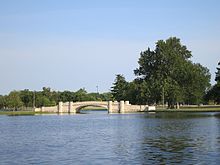
The Louisiana Purchase Exposition, informally known as the St. Louis World's Fair, was an international exposition held in St. Louis, Missouri, United States, from April 30 to December 1, 1904. Local, state, and federal funds totaling $15 million were used to finance the event. More than 60 countries and 43 of the then-45 American states maintained exhibition spaces at the fair, which was attended by nearly 19.7 million people.
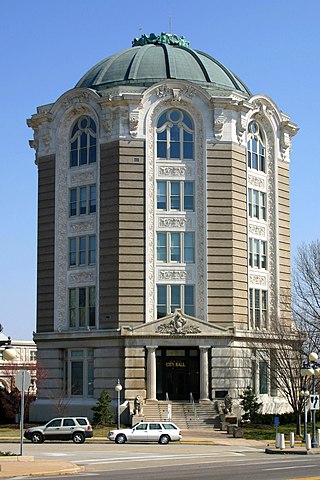
University City is an inner-ring suburb of the city of St. Louis in St. Louis County, in the U.S. state of Missouri. The population was measured at 35,065 by the 2020 census.
The Saint Louis Zoo, officially known as the Saint Louis Zoological Park, is a zoo in Forest Park, St. Louis, Missouri. It is recognized as a leading zoo in animal management, research, conservation, and education. The zoo is accredited by the Association of Zoos and Aquariums (AZA). Admission is free based on a public subsidy from a cultural tax district, the Metropolitan Zoological Park and Museum District (ZMD); fees are charged for some special attractions. A special feature is the 2 ft narrow-gauge Emerson Zooline Railroad with passenger trains pulled by Chance Rides C.P. Huntington locomotives that encircle the zoo, stopping at the more popular attractions.

The 1904 Summer Olympics were an international multi-sport event held in St. Louis, Missouri, United States, from 29 August to 3 September 1904, as part of an extended sports program lasting from 1 July to 23 November 1904, located at what is now known as Francis Olympic Field on the campus of Washington University in St. Louis. The 1904 Summer Olympics were the first time the Olympic Games were held outside Europe.
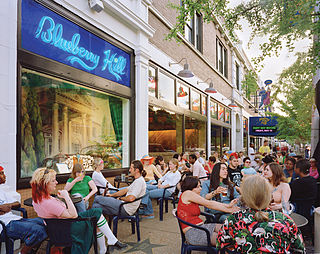
The Delmar Loop, often referred to by St. Louis residents simply as The Loop, is an entertainment, cultural and restaurant district in University City, Missouri and the adjoining western edge of St. Louis near Washington University in St. Louis and Forest Park. Many of its attractions are located in the streetcar suburb of University City, but the area is expanding eastward into the Skinker DeBaliviere neighborhood of the City of St. Louis. In 2007, the American Planning Association named the Delmar Loop "One of the 10 Great Streets in America."

Forest Park is a public park in western St. Louis, Missouri. It is a prominent civic center and covers 1,326 acres (5.37 km2). Opened in 1876, more than a decade after its proposal, the park has hosted several significant events, including the Louisiana Purchase Exposition of 1904 and the 1904 Summer Olympics. Bounded by Washington University in St. Louis, Skinker Boulevard, Lindell Boulevard, Kingshighway Boulevard, and Oakland Avenue, it is known as the "Heart of St. Louis" and features a variety of attractions, including the St. Louis Zoo, the St. Louis Art Museum, the Missouri History Museum, and the St. Louis Science Center.

David Rowland Francis was an American politician and diplomat. He served in various positions including Mayor of St. Louis, the 27th Governor of Missouri, and United States Secretary of the Interior. He was the U.S. Ambassador to Russia between 1916 and 1917, during the Russian Revolution of 1917. He was a Wilsonian Democrat.

The Central West End is a neighborhood in St. Louis, Missouri, stretching from Midtown's western edge to Union Boulevard and bordering on Forest Park with its array of free cultural institutions. It includes the Cathedral Basilica of Saint Louis on Lindell Boulevard at Newstead Avenue, which houses the second-largest collection of mosaics in the world. The Central West End sits entirely within the 9th Ward.

Grant's Farm is a historic farm, and long-standing landmark in Grantwood Village, Missouri, built by Ulysses S. Grant on land given to him and his wife by his father in law Frederick Fayette Dent shortly after they became married in 1848. It has also served as a residence of various members of the Busch family.
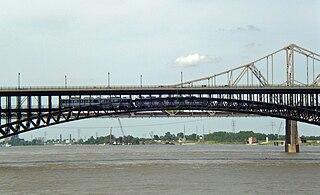
Transportation in Greater St. Louis, Missouri includes road, rail, ship, and air transportation modes connecting the bi-state St. Louis metropolitan area with surrounding communities throughout the Midwest, national transportation networks, and international locations. The Greater St. Louis region also supports a multi-modal transportation network that includes bus, paratransit, and light rail service in addition to shared-use paths, bike lanes and greenways.

The Missouri State Fair is the state fair for the state of Missouri, which has operated since 1901 in Sedalia, Missouri. It includes daily concerts, exhibits and competitions of animals, homemade crafts, shows, and many food/lemonade stands, and it lasts 11 days. The fairgrounds are located at 2503 W 16th Street on the southwest side of the city at the intersection of West 16th Street and South Limit Avenue.

Theodore C. Link, FAIA, was a German-born American architect and newspaper publisher. He designed buildings for the 1904 World's Fair, Louisiana State University, and the Mississippi State Capitol.
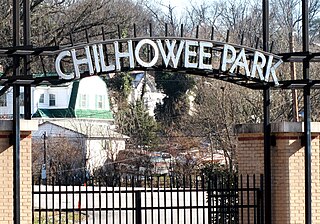
Chilhowee Park is a public park, fairgrounds and exhibition venue in Knoxville, Tennessee, United States, located off Magnolia Avenue in East Knoxville. Developed in the late 19th century, the park is home to the Tennessee Valley Fair and hosts several dozen expositions annually. The park covers 81 acres (33 ha), and includes a 57,100-square-foot (5,300 m2) exposition center, a 1910-era bandstand, a 4,500-seat amphitheater, and a 3-acre (1.2 ha) lake, Lake Ottosee. The park is also home to The Muse Knoxville, a children's science museum formerly known as the East Tennessee Discovery Center.

Skinker DeBaliviere is a neighborhood of St. Louis, Missouri, located directly north of Forest Park. In addition to the park, its boundaries are Delmar Boulevard to the north, DeBaliviere Avenue to the east, and the western city limits near Skinker Boulevard. It is home to The Pageant, Pin-up Bowl, and all the other establishments of the Delmar Loop east of University City. It also includes the west end of the Forest Park – DeBaliviere and the entire Skinker MetroLink stations. The Delmar Loop station is just outside of its north boundary. In 1978, the neighborhood was designated a Local Historic District by the City of St. Louis, and the private subdivision of Parkview is listed in the National Register of Historic Places.

The Saint Louis Exposition or St. Louis Expo was a series of annual agricultural and technical fairs held in St. Louis' Fairgrounds Park, from the 1850s to 1902. In 1904, the Louisiana Purchase Exposition, a major World's Fair, was held in St. Louis, Missouri. The annual agricultural/technical exposition was not held in 1903-4, and ceased after the World's Fair. Memorabilia from the annual St. Louis Expositions are sometimes confused with 1904 World's Fair memorabilia on auction websites.

Streetcars in St. Louis, Missouri, operated as part of the transportation network of St. Louis from the middle of the 19th century through the early 1960s.
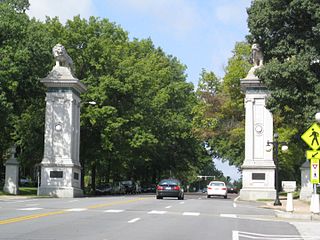
Delmar Boulevard is a major east-west street in St. Louis, Missouri, United States.

Andrew "Cap" Tilles was an American business magnate and philanthropist. At an early age, Tilles adopted his childhood nickname of Cap, which he used for the rest of his life. Tilles revolutionized the United States horse racing industry. Later in life, Tilles dedicated his resources to philanthropic projects in St. Louis, Missouri. In 1896, he co-founded and actively ran an investment syndicate that dominated the US horse racing industry through World War I. The investment syndicate became known in the media as the "Big Three," after its three principal partners: Louis A. Cella, Samuel W. Adler, and C. A. Tilles. The syndicate was officially known as C.A.T., which was short for the Cella, Adler, and Tilles partnership.

Benton Barracks was a Union Army military encampment, established during the American Civil War, in St. Louis, Missouri, at the present site of the St. Louis Fairground Park. Before the Civil War, the site was owned and used by the St. Louis Agricultural and Mechanical Association, which at the time was located on the outskirts of St. Louis. The barracks was used primarily as a training facility for Union soldiers attached to the Western Division of the Union Army.

Louis A. Cella was an American capitalist, turfman, and plutocratic political financier. In 1896, he co-founded the Cella, Adler, and Tilles investment syndicate, alongside partners Cap Tilles and Samuel Adler. The partnership, also known as C.A.T., dominated the Midwestern horse racing industry through World War I. At its height, C.A.T. had a controlling interest in 25 horse racing tracks. Additionally, C.A.T. founded the Western Turf Association, which granted Cella and his partners near monopolistic control over jockeys, bookmakers, and horse owners in the Midwest. The partnership also had one of the largest networks of bucketshops in the US, with a presence in every major city in the country. Cella was nicknamed the "Dago Saloonkeeper," a reference to his early start as a saloonist before co-founding C.A.T. Cella made a fortune in real estate, commodities speculation, stock commissions, and horse racing. At the height of his career, Cella owned five large office buildings, controlled ten theaters, several hotels, and a large network of brokerages across the US.
